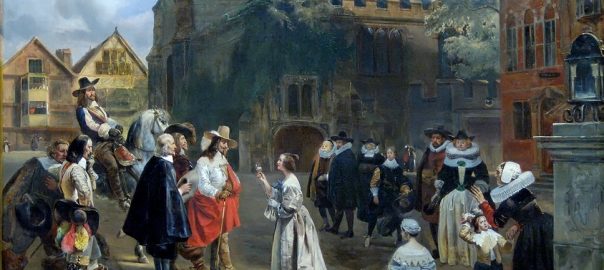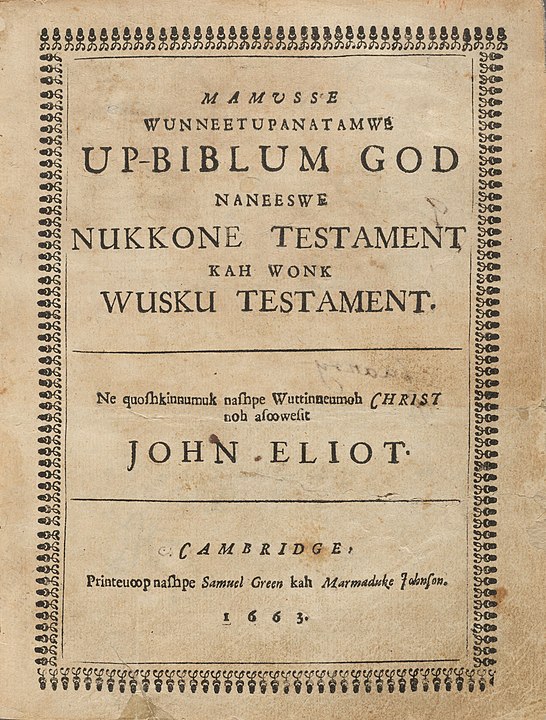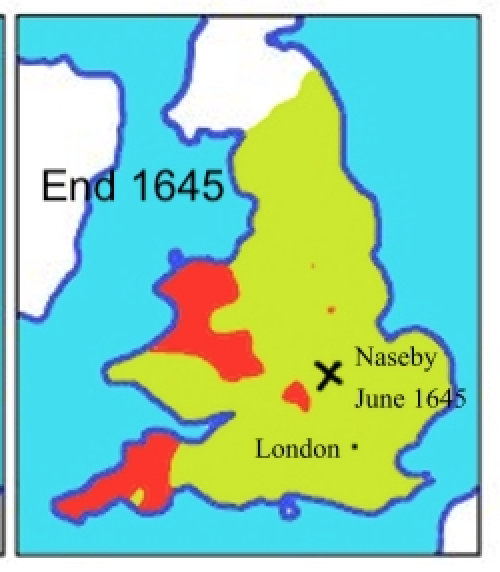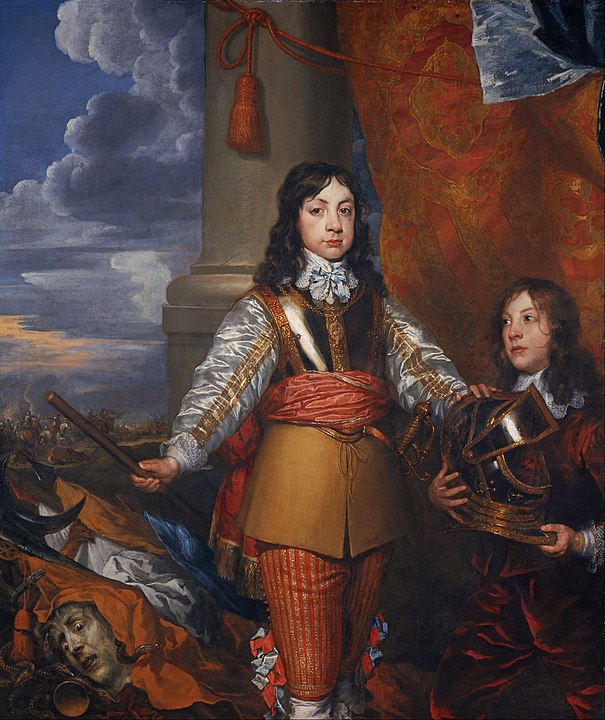The two major developments of 1646 CE that affected the history of Western imperialism were the Parliamentary victory in the first round of England’s civil war and a series of attempts the Dutch VOC navy made in the Indies to oust the Spanish from the Philippines. We will get to them below.
One smaller but definitely non-trivial event in 1646 was that in October, a preacher in the (Puritan) Massachusetts Bay Colony preached to a group of Native Americans of the Nipmuc (Algonquian) group in their own language and made a convert! He was called Waban. This was significant because none of the English colonists in North American had yet put much effort at all into Christianizing the Native peoples they encountered— and displaced– as they pursued their colonizing projects, though the various charters they had received from the English monarchs had all listed this prominently as a “goal” of the projects. That was in clear contrast to the practice of the Spanish in the Americas, who had fervently, and frequently with great cruelty and coercion, set about Christianizing the natives throughout the whole continent.
But here was John Eliot, a minister in Roxbury, Mass., who had worked for some years to learn the local Wampanoag language– which he did orally, from a seemingly enslaved Native; to develop a method of transcribing it; and then to publish basic Christian texts in transcribed Wampanoag as an aid to the conversion process. (The Spanish had been doing this for more than a century throughout the Americas, so the note in English-WP that the “Wampanoag Bible” that Eliot published in 1663 was “the first Bible printed in the New World” was completely wrong.)
Back to Waban. Here’s how English-WP describes his conversion and its immediate aftermath:
Waban was born about 1604 at Musketaquid, near the present town of Concord. His conversion to Christianity came on October 28, 1646 (Julian calendar), when the missionary Reverend John Eliot preached his first sermon to Native Americans in their own language in Waban’s large wigwam in Nonantum, Massachusetts, and Waban and many of his tribe listened but were later forced at gunpoint to move from their land.
So much for Christian love, Christian values, etc… On to the Philippines!
Dutch make big push against Spain in Philippines
Among the Western imperial powers in East Asia, by 1646 Portugal and England were the weaklings. It was really just Spain, now recently (1642) pushed off of Taiwan and back into their longheld position in the Philippines, and the muscular and brutal Dutch VOC navy that had done that pushing.
At some point in 1645, the VOC headquarters in Batavia (today’s Jakarta) decided to keep pushing. This WP page on the five naval battles that ensued in the waters of the Philippines, tells us this:
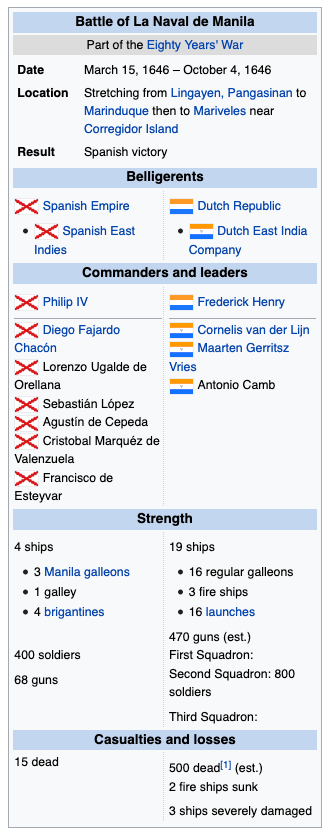
Fr. Juan de los Angeles, a Dominican priest who had been taken from Formosa [Taiwan] to Macassar by the Dutch as a prisoner of war, later described… that the Dutch were so eager to launch an attack on the Philippines that “they talk among themselves of nothing else than how they will gain Manila“, and that “they have urgently requested more men from Holland for the purpose of attacking Manila.” In his account, he also described the formidable force of the Dutch stationed at the ports of Jakarta in Indonesia and Formosa…
The position of the Spanish in the Philippines seemed pretty weak. They had been dealing with the earthquakes of the preceding years, various uprisings by Indigenes in the Philippines, serious problems in their communications routes– which connected to Spain only via a complex, globe-circling transit that included traversing today’s Mexico– and so on…
Long story short, the Dutch thought it would be a breeze, but after five attempts to beat the Spanish throughout 1646, they failed. The local Spanish archbishop declared Spain’s victory “a miracle.”
The Dutch fell back to Formosa and Jakarta. The lines of Western imperial influence in East Asia had been drawn– for now. Spain would retain control of the Philippines until 1898.
England’s Parliament wins on battlefield, works to translate that into political victory
At two battles in March 1646, Parliament’s newly organized fighting force the New Model Army won its final victory on the battlefield. As the map I included yesterday showed, at the end of 1645 the Royalists (red) retained only the Devon/Cornwall peninsula and a couple of small spots in the Cotswolds and north Wales. The NMA defeated the Royalists in Devon on March 12, and nine days later they routed the Royalists in the Costwolds.
This page on English-WP tells us what happened next:
With the end of the war in sight, Parliament issued a proclamation, allowing favourable terms for any Royalists who ‘compounded’ [surrendered] prior to 1 May. Those whose estates had been confiscated could regain them on payment of a fine, which was calculated on the value of their lands, and level of support; many took advantage of this.
After capturing Exeter and Barnstaple in April, the New Model marched on Oxford; on 27 April, Charles [who had been directing the Royalist effort from there since 1642] left the city in disguise, accompanied by two others..
Now, over to the WP page on King Charles himself, which tells us that Charles had escaped from Oxford dressed as a servant. And then:
He put himself into the hands of the Scottish presbyterian army besieging Newark, and was taken northwards to Newcastle upon Tyne. After nine months of negotiations, the Scots finally arrived at an agreement with the English Parliament: in exchange for £100,000, and the promise of more money in the future, the Scots withdrew from Newcastle and delivered Charles to the parliamentary commissioners in January 1647.
I’m going to take this story forward a couple of years beyond 1646 so we don’t have to keep revisiting it. After the Scots delivered Charles to the Parliament leaders in January 1647, this happened: Parliament held Charles under house arrest in Northamptonshire until June, when a low-ranking NMA officer called George Joyce grabbed him there in the name of the NMA. WP tells us:
By this time, mutual suspicion had developed between Parliament, which favoured army disbandment and presbyterianism, and the New Model Army, which was primarily officered by congregationalist Independents, who sought a greater political role. Charles was eager to exploit the widening divisions, and apparently viewed Joyce’s actions as an opportunity rather than a threat. He was taken first to Newmarket, at his own suggestion, and… subsequently Hampton Court [near London], while more ultimately fruitless negotiations took place. By November, he determined that it would be in his best interests to escape..
He escaped from Hampton Court on November 11, 1647 and sought refuge from a local governor on the Isle of Wight whom he judged– wrongly– would be sympathetic, and who imprisoned him in Carrisbrooke Castle. (The banner image at the top here is a detail from an 18th century painting of Charles at Carrisbrooke.)
Then this:
From Carisbrooke, Charles continued to try to bargain with the various parties. In direct contrast to his previous conflict with the Scottish Kirk, on 26 December 1647 he signed a secret treaty with the Scots [under which]… the Scots undertook to invade England on Charles’s behalf and restore him to the throne on condition that presbyterianism be established in England for three years.
The royalists rose in May 1648, igniting the Second Civil War, and as agreed with Charles, the Scots invaded England. Uprisings in Kent, Essex, and Cumberland, and a rebellion in South Wales, were put down by the New Model Army, and with the defeat of the Scots at the Battle of Preston in August 1648, the royalists lost any chance of winning the war.
Charles’s only recourse was to return to negotiations, which were held at Newport on the Isle of Wight. On 5 December 1648, Parliament voted by 129 to 83 to continue negotiating with the king, but Oliver Cromwell and the army opposed any further talks with someone they viewed as a bloody tyrant and were already taking action to consolidate their power… In Pride’s Purge on 6 and 7 December, the members of Parliament out of sympathy with the military were arrested or excluded by Colonel Thomas Pride, while others stayed away voluntarily. The remaining members formed the Rump Parliament. It was effectively a military coup.
There are a couple of interesting footnotes here. One is just to note the religious/sectarian as well as political complexity of the decision-making on the Parliamentary side. The other is to see what happened to many of the Royalists at the various points from early 1646 onwards when it seemed to them their Royalism was a lost cause.
Charles’s Crown Prince– also Charles, later King Charles II– had been born in 1630, and experienced the First Civil War as a young teen, holing up with his father and the remaining loyalists in Oxford. In 1645 he was made titular commander of the English forces in the West Country. “By spring 1646, his father was losing the war, and Charles left England due to fears for his safety. Setting off from Falmouth [in Devon] … he went first to the Isles of Scilly, then to Jersey, and finally to France, where his mother was already living in exile and his first cousin, eight-year-old Louis XIV, was king.”
One of the many Royalist supporters he also found taking refuge in Paris at that times was the philosopher Thomas Hobbes, then already at work on his major work of political philosophy, Leviathan. WP tells us this: “In 1647, Hobbes took up a position as mathematical instructor to the young Charles, Prince of Wales, who had come to Paris from Jersey around July. This engagement lasted until 1648 when Charles went to Holland.”
Other Royalists fled to the English colonies in the Americas. One of these was the writer Richard Ligon, about whom WP tells us only a little: “On 14 June 1647, he left for Barbados to gain his fortune in the New World, like many of his fellow countrymen. Ligon purchased half of a sugar plantation in Barbados. After two years residence on the island he was attacked by a fever, and returned to England in 1650. He was soon afterward put into prison by his creditors.”
Ligon wrote an intriguing study of plantation life on Barbados, a modern reprint of which I am currently reading. Excerpts, to come.
